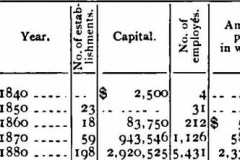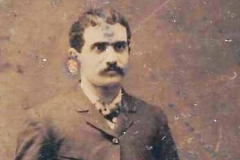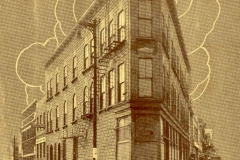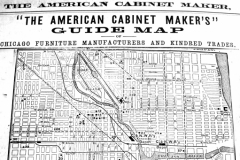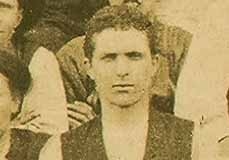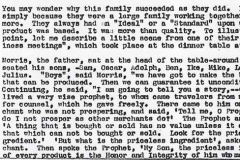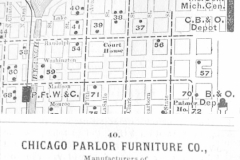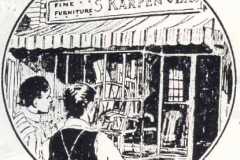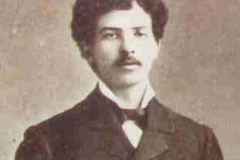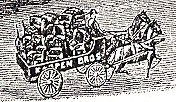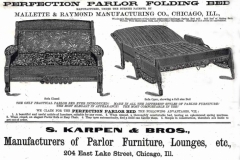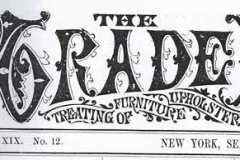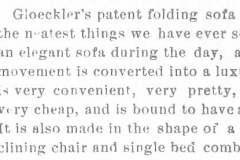Moritz Karpen’s Cherished Dream—The Founding of S. Karpen & Bros.: 1880-1884
It was a dream that had to do with the manufacture of furniture in his adopted land, of a business free from the hampering conditions of the Old World, of a factory that could use to the utmost the most progressive of New World ideas, and blend with them the idealism of the craftsmen of the Old World, to whom the building of furniture was an art, and not merely a factory industry. —Chicago Furniture Manufacturers Association. “The Story of Karpen.” Chicago: Chicago Furniture Manufacturers’Association, August 26, 1930.
1880-1882
The story of the Karpens over the decades in Chicago contributed to, and paralleled, the growth of the furniture business in Chicago. In 1878 Chicago’s furniture factories product was valued at about $4,000,000. [2] And then it took off. With the population of Chicago in 1880 growing to ca. 500,000, [3] an economic census held in June 1880 indicated that the number of furniture manufacturers numbered at 198, with 5,462 employees, producing $7,447,289 of goods. Of that number, 19 were upholstery establishments with 140 employees, producing $225,195 of goods.[4]
Solomon Karpen was gifted with the ability to save money. From 1878 to 1880 he accumulated the sum of $580[5] so he decided to go into business for himself. [6]
On August 5, 1881, Solomon, at age 23½, founded S. Karpen & Bros. [8] We need to note here that the year of founding was actually 1881. However at some point, the company changed the year of its founding to 1880.
In the European tradition that crossed the ocean to new shops and manufacturing businesses, the founder named his company for himself and his brothers: S. Karpen & Bros.
It was a momentous event for a young immigrant after merely eight years in America. Solomon, however, was up to the challenge. His brother Isaac “Ike” recalled that he, at age 15, drove the first tack in the first frame Solomon had purchased for his initial effort. …. As he started that tack and drove it in with the hammer, he declared “Here goes the first tack.”[9]
Solomon Karpen started his first workshop in the basement of a building located at Milwaukee Avenue and Tell Place (now W. Thomas St.), Chicago. [11] The substantial building was located about two blocks from the family’s rented home in the Northwest section of Chicago.
Few, if any of Chicago’s approximately 150 furniture shops,[12] were located in the immediate area on Milwaukee Avenue north of Chicago Avenue, but several factories were located south of Chicago Avenue.[13]
“I hired a youngster or two as helpers,” Solomon recalled decades later, “and used to make my goods, mostly parlor suites, during the day, while in the late afternoon or evening I would go out and sell them to furniture dealers.”[14] Then his brothers began to join him.
As soon as he was well established, Oscar, at age 22, started working with him. He had been trained and worked as a gilder, specialized in finishing.[15] They bought the bare frames of chairs, and their “manufacturing” consisted of upholstering and finishing them.[16]
The shop bore a strong resemblance to the old-world shop in which their father had worked. [17] The young men had only a few machines and tools because that was all that was needed. They owned hardly any more tools than could be packed into an ordinary-sized carpenter’s tool box. In one room they did the upholstering; in the other they cleaned and stored the finished furniture.[18]
Isaac “Ike” (age 16) and Michael “Mike” (age 15) joined the fledging business. Ike left his apprenticeship to a druggist. The young teenagers were the delivery boys who carried the completed chairs and sofas on their backs[19] to the retail dealers.[20] [21] They also hauled pieces on their backs to photographers’ studios.
From day one, first-class quality was of the utmost importance. Solomon bragged that “every penny was made to do double duty, but one thing we did not skimp on was workmanship.” Again Ike remembered the day when they “finished that first upholstering job and … Ike drew his hand smoothly and caressingly over the seat and back—brushing away the dust and standing back a bit to look it over—saying… “pretty nice, eh?” They placed a chair on his back and started for the photographers. “But, Solomon thought it over evidently, and decided it was not good enough to photograph, came running after us and we carried it back to the shop again.”[23]
Solomon recalled, “if screws were needed instead of nails to make a chair more durable, or, if extra springs were required to make it more comfortable and durable, we incurred the expense of the screws and extra springs. I thought then that any scheme of economy, which called for omitting them, would have been the height of extravagance.”[24]
Early on Solomon gained the trust of the financial community for his fledgling enterprise. As Solomon described, “the plan we followed, roughly, was to make our profits supply the additional capital we constantly found ourselves in need of. To do this, my brothers and I kept our living expenses at the lowest possible limit. We might draw as much as eight or ten dollars a week, but seldom more. We called the rest profit.[25] Our profits the first year, on the initial investment of $580, amounted to over $7,000. This saw us through….How surprised we were when we took our first inventory and found that it amounted to $1800.” [26] According to an 1908 furniture trade journal profile, the first year the firm was in business its sales amounted to about $25,000. [27]
This careful planning was appreciated by the very important R. G. Dun & Company, the credit rating company whose reports were the basis for most financial transactions. In autumn 1881, R.G. Dun & Company issued its first report in which the agent stated that the furniture company, S. Karpen & Bros., was located at 762 Milwaukee Ave. The “firm was composed of Solomon and Oscar. They owe nothing having thus far bought for cash and have no outside means. This statement is believed to be substantially correct. Both single young men. Started in this business about six weeks ago. For some years previously they were employed in a furniture factory in this City. Their late employers speak very favorably of them, saying they are honest, industrious, prudent young men of good character and habits. Regard them as a fair risk for small lines.” (Illinois, Vol. 40, p.51, R.G. Dun & Co. Credit Report Volumes, Baker Library, Harvard Business School. [Abbreviations and punctuation adapted for easier reading]).
This credit-rating report, compared to other assessments of new businesses—and, especially new businesses owned by young Jewish immigrants,—was amazingly glowing.
Solomon described his first business plan: “Soon after starting, I made tentative advances towards a formal financial program. I called on a banker, and described the manufacturing business I had and hoped to have. ‘I expect to increase my sales by giving longer time to dealers,’ I explained. ‘I will get my money from customers as fast as possible, for I haven’t much capital. I don’t need to borrow any money now, but some of these days I may want some accommodation.’ ‘When you do,’ he said, willingly enough, ‘come and we’ll talk it over.’ But I never went; at least, not until long afterwards.”[29]
The business expanded rapidly. After three months, the business required larger quarters;[30] it moved to 204 Lake Street[31][32] where they rented a building measuring 35 feet by 175 feet. The building was in the Northwest section of Chicago about a mile and a half from their home. Several other furniture manufacturing factories were located within a few blocks radius of their factory on Lake Street between S. Franklin Street and Fifth Avenue.[33] Solomon was planning for future expansion so he rented a space with two lofts. [34] At 204 Lake Street, S. Karpen & Bros. now boasted a salesroom as well as a factory. [35] But according to Solomon, “everybody said we were crazy and that we would go broke within a month.”[36]
1882-1884
1882 marked a turning point in the course of S. Karpen & Bros. Adolph, at age 22, had graduated from the Chicago College of Pharmacy in 1881, and worked as a druggist.[37] After his graduation, however, “constant application to his studies and to business impaired his health and necessitated a temporary withdrawal from the confinement his calling demanded. Consequently, in 1882, he associated himself with his brother in the furniture manufacturing business.”[38][39] [40] Adolph took on the sales and marketing responsibilities.
In 1882 the R.G. Dun & Company credit rating company agent again wrote about the firm now at 204 Lake St. “They originally came here in ′72. Commenced…August ′81. Solomon and Oscar formerly in employ of R. Deimel & Bros. Adolph was with J.G. Schaar Drugs. Solomon states they are worth $2,000 all in the business. …Are industrious, saving, … a fair risk for little short-time bills.” (Illinois, Vol. 40, p.51, R.G. Dun & Co. Credit Report Volumes, Baker Library, Harvard Business School. [Abbreviations and punctuation adapted for easier reading]).
The family moved just a few blocks north to 563 Noble Street,[44] the same building where Solomon and Oscar’s former employers, the Deimel family, had lived.[45] At age 58, Moritz was still working by himself as a carpenter[46] and cabinetmaker.[47]
The boys no longer had to carry the heavy pieces on their backs; they used the horse for deliveries with a horse and wagon.[49]
The R. G. Dun & Company agent reported in 1883 that their inventory was worth about $5,000 and their accounts were at $2,000. Their fixed assets included a horse and $300 cash. “They are young, single men of excellent habits, have a sure trade, and believe entitled to credence. A moderate, careful business, prompt payment and fair credit for reasonable business wants.” (Illinois, Vol. 40, p.51, R.G. Dun & Co. Credit Report Volumes, Baker Library, Harvard Business School. [Abbreviations and punctuation adapted for easier reading]).
S. Karpen & Bros. was ready to emerge onto the Chicago and national scenes. This paralleled the growth of the furniture industry in the city. Chicago’s shops and factories, numbering more than 150 establishments,[50] manufactured nearly $11,000,000 worth of furniture in 1882[51], an increase of over $3,500,000 in two years. [52]
These new companies were poised to market to the new life style of the majority of Americans. An interior design commentator wrote in 1878: “I use the word ‘Living-Room’ instead of ‘Parlor,’ because I am not intending to have anything to say about parlors…. None but rich people can afford to have a room in their houses set apart for the pleasures of idleness…. Happily, the notion that such a room is absolutely necessary to every respectable family is no longer so prevalent…. They are useless and out of place in the houses of nine-tenths of our Americans.”[53] The word “living room” was a new concept that began appearing in the media.
Adolph undertook several important marketing initiatives. Established furniture manufacturers employed traveling salesmen with most companies having six to ten “drummers,” covering specific geographical areas. [54] In 1883 S. Karpen & Bros. listed Adolph and Mich. Parker as its traveling salesmen.[55] A year later, “Mr. Williams Hobs, representing S. Karpen Bros., started South on his first trip.”[56]
With salesmen on the road, the company needed a printed catalog and price list. While wholesale salesmen in businesses like novelties, clothing, and hardware could carry physical samples of their wares, wholesale furniture salesmen could not do that. Karpen Bros.’ first catalog and price list was available in Fall 1883. [57]
From the start, the company looked for furniture they could sell with ease. A folding bed was a good venture. It manufactured the Perfection Parlor Folding Bed under the patent held by a local company, Mallette, Raymond & Co. This was one of the first advertisements for Karpen furniture in an important trade journal.
Adolph understood the importance of free publicity that could be garnered in the trade press. The Trade Bureau: Treating of Furniture, Upholstery, Decoration & Kindred Industries. (Published weekly, 150 Canal St., New York. Subscription $3.00 per annum; single copies 10 cents.) was the most important furniture trade paper of the time. The reporter/representative spoke with members of the wholesale furniture manufacturing industry and retail dealers, and made weekly reports listed under geographical areas. Most likely, Adolph would have communicated with the reporter often. In August 1883, S. Karpen & Bros. merited their first mention in The Trade Bureau: “Messrs. Karpen Bros., enterprising manufacturers of parlor furniture, are now making some very tasteful suites, easy corner chairs, rockers and divans. They are in their new factory at 218 [sic] Lake Street, where three large floors hardly afford them room for work.”[58]
The Trade Bureau subsequently reported that Karpen Bros. announced that it also had the exclusive control for the Northwest of Gloeckler’s folding sofa bed:[59]
Retail store owners and buyers took notice of the positive remarks. Adolph also initiated Karpen Bros.’ first advertising campaign. He placed an advertisement in The American Furniture Gazette in 1884 that set the company apart from other furniture manufacturers. The advertisement included an innovative advertising concept: Karpen Bros. would guarantee the goods it manufactured.
We quote below the very lowest prices at which these sofa beds can be made, and take all risk of possible dissatisfaction from the fact that we know that you cannot help being pleased with them. We guarantee these beds; and parties ordering samples can return them if not found entirely satisfactory, but in every case complaints must be made promptly on receipt of goods.[60]
“Karpen” was used as the company’s trade-mark starting in 1884. However, it was not registered with the United States Patent Office until 1940 (Trade-Mark No. 375,991; registered March 12, 1940).
- Chicago Furniture Manufacturers Association, The Story of Karpen (Chicago: Chicago Furniture Manufacturers Association, August 26, 1930). ↑
- American Cabinet Maker and Upholsterer, Nov. 25, 1882, 16. ↑
- Almanac and Year-Book for 1925 (Chicago: The Chicago Daily News, 1924) 902. ↑
- Official Manufacturers Census reports, The Trade Bureau, June 17, 1893, n.p. Furniture Journal, Oct. 9, 1908, 102-103. ↑
- Neil Clark, “How Nine Brothers Built Up a $10,000,000 Business,” Forbes, Aug. 1, 1926, 10. S. Karpen & Bros, S. Karpen & Bros. Furniture Catalog (Chicago: S. Karpen & Bros. 1927), 2. ↑
- Neil Clark, “How Nine Brothers Built Up a $10,000,000 Business,” Forbes, Aug. 1, 1926, 10. ↑
- S. Karpen & Bros., How to Know Upholstered Furniture (Chicago: S. Karpen & Bros. 1901), 1. ↑
- Daily Inter Ocean (Chicago), Jan. 1, 1892. Furniture Journal, Oct. 9, 1908, 121. ↑
- Employees of Karpen Upholstering Department, In Memory of Isaac Karpen (1918), 4-5. ↑
- Chicago Furniture Manufacturers Association, The Story of Karpen (Chicago: Chicago Furniture Manufacturers Association, August 26, 1930). ↑
- Neil Clark, “How Nine Brothers Built Up a $10,000,000 Business,” Forbes, Aug. 1, 1926, 10. ↑
- Furniture Journal, Oct. 9, 1908, 103. ↑
- “ ‘The American Cabinet Makers’ Guide Map of Chicago Furniture Manufacturers and Kindred Trades,” American Cabinet Maker and Upholsterer, Aug. 21, 1880, 16-17. ↑
- Solomon Karpen in Neil Clark, “How Nine Brothers Built Up a $10,000,000 Business,” Forbes, Aug. 1, 1926, 10. ↑
- Lakeside Directory of Chicago, 1882, 663 ↑
- Solomon Karpen in Neil Clark, “How Nine Brothers Built Up a $10,000,000 Business,” Forbes, Aug. 1, 1926, 10. ↑
- Solomon Karpen in Neil Clark, “How Nine Brothers Built Up a $10,000,000 Business,” Forbes, Aug. 1, 1926, 10. ↑
- Solomon Karpen in Neil Clark, “How Nine Brothers Built Up a $10,000,000 Business,” Forbes, Aug. 1, 1926, 11. ↑
- Isaac Karpen. ↑
- Solomon Karpen in Carl Saunders, “They Called Us Crazy, but ─,”[An Interview with Sam Karpen] Furniture Manufacturer, Sept. 1930. (reprinted by S. Karpen & Bros, “Karpen Celebrates Half Century of Service.”), [1]. ↑
- Isaac Karpen and “Funeral Today on Coast for Mike Karpen,” Retailing Daily: Home Furnishings Newspaper, New York, July 3, 1950, 1. ↑
- Furniture Manufacturer, Sept. 1930, 42. ↑
- Employees of Karpen Upholstering Dept., In Memory of Isaac Karpen., 1918, 5-6. ↑
- Solomon Karpen in Neil Clark, “How Nine Brothers Built Up a $10,000,000 Business,” Forbes, Aug. 1, 1926, 10. ↑
- Solomon Karpen in Carl Saunders, “They Called Us Crazy, but ─,”[An Interview with Sam Karpen] Furniture Manufacturer, September, 1930. (reprinted by S. Karpen & Bros, “Karpen Celebrates Half Century of Service.”), [1]. ↑
- Solomon Karpen in Neil Clark, “How Nine Brothers Built Up a $10,000,000 Business,” Forbes, Aug. 1, 1926, 10. ↑
- Furniture Journal, Oct. 9, 1908, 121. ↑
- Illinois, Vol. 40, p.51, R.G. Dun & Co. Credit Report Volumes, Baker Library, Harvard Business School. [Abbreviations and punctuation adapted for easier reading]. ↑
- Solomon Karpen in Neil Clark, “How Nine Brothers Built Up a $10,000,000 Business,” Forbes, Aug. 1, 1926, 10. ↑
- “Funeral Today on Coast for Mike Karpen,” Retailing Daily: Home Furnishings Newspaper, New York, July 3, 1950, 1. ↑
- American Cabinet Maker and Upholsterer, Aug. 13, 1887, 23-4. ↑
- American Cabinet Maker and Upholsterer, July 28, 1894, 20. ↑
- “ ‘The American Cabinet Makers’ Guide Map of Chicago Furniture Manufacturers and Kindred Trades,” American Cabinet Maker and Upholsterer, Aug. 21, 1880, 16-17. ↑
- Furniture Journal, Oct. 9, 1908, 121. ↑
- American Cabinet Maker and Upholsterer, June 24, 1899, 12. ↑
- Solomon Karpen in Carl Saunders, “They Called Us Crazy, but ─,”[An Interview with Sam Karpen] Furniture Manufacturer, September 1930. (reprinted by S. Karpen & Bros, “Karpen Celebrates Half Century of Service.”), [1]. ↑
- Lakeside Directory of Chicago, 1880, 613. Lakeside Directory of Chicago, 1882, 663. Daily Inter-Ocean (Chicago), Mar. 11, 1881. ↑
- Alfred Andreas, History of Chicago, 1871-1885. Vol. 3 (Chicago: 1884), 550. ↑
- American Cabinet Maker and Upholsterer, Aug. 13, 1887, 23-4. ↑
- Furniture Journal, Oct. 9, 1908, 121. ↑
- National Archives and Records Administration (NARA); Washington, D.C.; Soundex Index to Naturalization Petitions for the United States District and Circuit Courts, Northern District of Illinois and Immigration and Naturalization Service District 9, 1840-1950 (M1285); Microfilm Serial: M1285; Microfilm Roll: 104. ↑
- American Cabinet Maker and Upholsterer, Aug. 13, 1887, 23-4. ↑
- Illinois, Vol. 40, p.51, R.G. Dun & Co. Credit Report Volumes, Baker Library, Harvard Business School. [Abbreviations and punctuation adapted for easier reading]. ↑
- Lakeside Directory of Chicago, 1882, 663. ↑
- Lakeside Directory of Chicago, 1876-7, 313. Lakeside Directory of Chicago, 1877-8, 306, 319. ↑
- Lakeside Directory of Chicago, 1881, 650. Lakeside Directory of Chicago, 1883, 672. and 1884 ↑
- Lakeside Directory of Chicago, 1882, 663. ↑
- Illinois, Vol. 40, p.51, R.G. Dun & Co. Credit Report Volumes, Baker Library, Harvard Business School. [Abbreviations and punctuation adapted for easier reading]. ↑
- “Career of Mike Karpen Bridges Horses to Air,” Chicago Market Daily, 1948. 61. ↑
- Furniture Journal, Oct. 9, 1908, 103. ↑
- American Cabinet Maker and Upholsterer, Nov. 25, 1882, 16. ↑
- Official Manufacturers Census reports, The Trade Bureau, June 17, 1893, n.p. ↑
- Clarence Cook, The House Beautiful: Essays on Beds and Tables, Stools and Candlesticks (New York: Scribner, Armstrong & Company, 1878), 45. ↑
- American Cabinet Maker and Upholsterer, Feb. 10, 1883, 11B. ↑
- American Cabinet Maker and Upholsterer, Feb. 10, 1883, 11B. ↑
- Trade Bureau, Feb. 23, 1884, 36. ↑
- Trade Bureau, Nov. 3, 1883. ↑
- Trade Bureau, Aug. 25, 1883, 1. ↑
- Trade Bureau, Nov. 3, 1883, 20. ↑
- American Furniture Gazette, Fall 1884, xxv.↑
-
